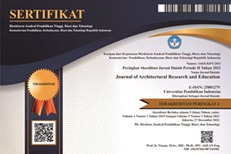Strategy of Visual Connection with Nature Through The Building-Integrated Vegetation Approach on The Campus Environment (Case Studies: UMN Campus in Gading Serpong and Binus Campus in Alam Sutera)
Abstract
Rapid urbanization in recent decades has increasingly separated humans from nature. Campuses that have been associated with 'tiny cities' hold significant potential to promote it. This conscious effort by humans to affiliate with nature through the built environment is called biophilic design. One strategy for biophilic implementation is through visual connection with nature by integrating vegetation into the building. This study aims to explore the application of building-integrated vegetation (BIV) in urban campuses and examine the perceived sensory dimensions by users. A case study approach was employed on two urban campuses: Binus University in Alam Sutera and UMN University in Gading Serpong. The qualitative method is the place-centered mapping technique. Data were collected through physical observation, document analysis, and questionnaires. Visual and spatial data were analyzed to explore the implementation of BIV, while questionnaire data were analyzed to examine user perceptions. The findings reveal that both campuses applied vegetation to buildings through outdoor gardens, indoor gardens, and rooftop gardens. The study also found that users experienced natural ambiance, tranquility, openness, and biodiversity when visually connected to nature. These findings provide relevant insights and recommendations for campus designers to create healthier and more sustainable learning environments through the application of BIV.
Keywords
Full Text:
PDFReferences
Alves, S., Gulwadi, G. B., Nilsson, P., & Manzo, L. C. (2022). An Exploration of How Biophilic Attributes on Campuses Might Support Student Connectedness to Nature, Others, and Self. Frontiers in Psychology, 12(April), 1–14. https://doi.org/10.3389/fpsyg.2021.793175
Arnold, K., Gosztonyi, S., & Luible, A. (2021). Wind Forces in Uvergrown Rope Façades - Wind Tunnel Tests on Five Climbing Plants. Journal of Facade Design and Engineering, 9(2), 95–118. https://doi.org/10.7480/jfde.2021.2.4833
Browning, W. D., & Ryan, C. O. (2020). Nature Inside: A biophilic design guide (1st Editio). RIBA Publishing. https://doi.org/https://doi.org/10.4324/9781003033011
Browning, W., Ryan, C., & Clancy, J. (2014). 14 Patterns of Biophilic Design: Improving Health & Well-being in the Built Environment. In Terrapin Bright Green (Vol. 1). Terrapin Bright Green llc.
Elgizawy, E. M. (2016). The Effect of Green Facades in Landscape Ecology. Procedia Environmental Sciences, 34, 119–130. https://doi.org/10.1016/j.proenv.2016.04.012
Guswaldi, G. B., Mishchenko, E. D., Hallowell, G., Susana, A., & Kennedy, M. (2019). The Restorative Potential of A University Campus: Objective Greenness and Student Perceptions in Turkey and the United States. Landscape and Urban Planning, 187(July), 36–46.
Kellert, S. R. (2008). Dimensions, Elements, and Attributes of Biophilic Design. In S. R. Kellert, J. H. Heerwagen, & M. L. Mador (Eds.), Biophilic Design (1st editio, pp. 3–25). John Wiley & Sons, Ltd. https://www.researchgate.net/profile/Stephen_Kellert/publication/284608721_Dimensions_elements_and_attributes_of_biophilic_design/links/56619da108ae4931cd59f2ed.pdf
Kellert, S. R. (2018). Nature by Design: The Practice of Biophilic Design (1st edition). Yale University Press.
Kellert, S. R., & Calabrese, E. F. (2015). The Practice of Biophilic Design. In www.biophilic-design.com (Vol. 54, Issue 1). www.biophilic-design.com. https://doi.org/10.1063/1.1387590
Kellert, S. R., Heerwagen, J., & Mador, M. (2008). Biophilic Design: The Theory, Science, and Practice of Bringing Buildings to Life (1st editio). John Wiley & Sons.
Liu, Q., Zhang, Y., Lin, Y., You, D., Zhang, W., Huang, Q., van den Bosch, C. C. K., & Lan, S. (2018). The Relationship between Self-rated Naturalness of University Green Space and Students’ Restoration and Health. Urban Forestry & Urban Greening, 34, 259–268 Contents.
Malekinezhad, F., Courtney, P., Lamit, H., & Vigani, M. (2020). Investigating the Mental Health Impacts of University Campus Green Space Through Perceived Sensory Dimensions and the Mediation Effects of Perceived Restorativeness on Restoration Experience. Frontiers in Public Health, 8(December), 1–14. https://doi.org/10.3389/fpubh.2020.578241
Marugg, C. A. (2019). Vertical Forests: The Impact of Green Balconies by Solar Shading, Evapotranspiration and Wind Flow Change. In Delft University of Technology (Issue 1).
Memari, S., Pazhouhanfar, M., & Grahn, P. (2021). Perceived Sensory Dimensions of Green Areas: an Experimental Study on Stress Recovery. Sustainability, 13(5419), 1–19. https://doi.org/10.3390/su13105419
Othman, A. R., & Sahidin, N. (2016). Vertical Greening Façade as Passive Approach in Sustainable Design. Procedia - Social and Behavioral Sciences, 222, 845–854. https://doi.org/10.1016/j.sbspro.2016.05.185
Peters, T., & D’Penna, K. (2020). Biophilic Design for Restorative University Learning Environments: A Critical Review of Literature and Design Recommendations. Sustainability, 12(7064), 1–17.
Pradono, B. (2019). The Interiority of Proximity between Nature and Architecture in Contemporary and Tropically Context with Cases Studies. ARTEKS Jurnal Teknik Arsitektur, 3(2), 115–129. https://doi.org/10.30822/artk.v3i2.212
Raji, B., Tenpierik, M. J., & Van Den Dobbelsteen, A. (2015). The Impact of Greening Systems on Building Energy Performance: A Literature Review. Science Direct: Renewable and Sustainable Energy Reviews, 45(1), 610–623.
Ratnasari, A., & Dwisusanto, Y. B. (2024a). Interaksi Manusia dan Lingkungan dalam Kajian Filosofis. Jurnal MARKA (Media Arsitektur Dan Kota), 7(2), 195–208. https://doi.org/https://doi.org/10.33510/marka.2024.7.2.195-208
Ratnasari, A., & Dwisusanto, Y. B. (2024b). Tren Penelitian Biofilik: Sebuah Tinjauan Literatur dengan Analisis Bibliometrik. Jurnal MARKA (Media Arsitektur Dan Kota), 8(1), 35–46. https://doi.org/10.33510/marka
Ratnasari, A., Dwisusanto, Y. B., & Sahid, S. (2025). Biophilic Design as a Bridge for Human-Environment Interaction to Enhance Users’ Health and Well-Being. IOP Conference Series: Earth and Environmental Science, 1488. https://doi.org/10.1088/1755-1315/1488/1/012068
Ratnasari, A., Dwisusanto, Y. B., & Sahid, S. (2024b). Environmental and Life Sciences The Rationale of Biophilic Design: from Theory to Practice (pre-press). AIC: Annual International Conference 2024 in Environmental and Life Science, 80–87.
Sheweka, S., & Magdy, N. (2011). The Living Walls as An Approach for A Healthy Urban Environment. Energy Procedia, 6, 592–599. https://doi.org/10.1016/j.egypro.2011.05.068
Stoltz, J., & Grahn, P. (2021a). Perceived Sensory Dimensions: An Evidence-based Approach to Greenspace Aesthetics. Urban Forestry and Urban Greening, 59, 126989. https://doi.org/10.1016/j.ufug.2021.126989
Stoltz, J., & Grahn, P. (2021b). Perceived Sensory Dimensions: Key Aesthetic Qualities for Health-promoting Urban Green Spaces. Journal of Biomed Research, 2(1), 22–29. https://doi.org/10.46439/biomedres.2.009
Sugianto, E., Ratnasari, A., & Hibrawan, A. (2024). Perancangan Mental Healthcare Center di Gading Serpong dengan Pendekatan Arsitektur Biofilik. Jurnal Arsitektur RUSTIC, 4(1), 14–29.
Zhang, J., Jin, J., & Liang, Y. (2024). The Impact of Green Space on University Students’ Mental Health: The Mediating Roles of Solitude Competence and Perceptual Restoration. Sustainability, 16(707), 1–28.
DOI: https://doi.org/10.17509/jare.v7i1.86792
Refbacks
- There are currently no refbacks.
Copyright (c) 2025 Journal of Architectural Research and Education

This work is licensed under a Creative Commons Attribution-NonCommercial-ShareAlike 4.0 International License.

This work is licensed under a Creative Commons Attribution-ShareAlike 4.0 International License.








